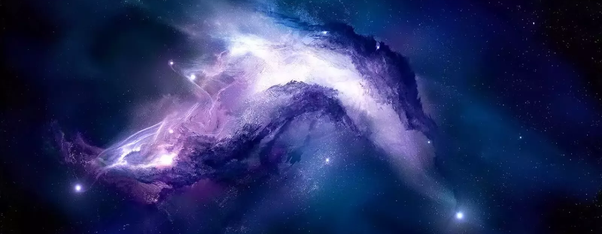We can never visit 99.99999999999% of the observable universe.
Wait, what? Why? I hear you say.
Well, galaxies are clustered together in groups, and our galaxy is a part of a group imaginably called the local group which consists of about 54 galaxies, and is 10231023 meters wide, or about 10 million light years.
The catch? We can never leave the local group.
That doesn't sound too bad; 10 million light years is quite a lot of room. We don't need more than that; do we?
Maybe not, however, the observable universe is 46.6 billion light years across.
This means we can only reach 0.00000000001% (that's 10 zeros) of the universe; the other 99.99999999999% will be forever out of reach for humankind given our current understanding of physics.
But just why are we trapped in the local group?
The galaxies in a cluster are bound together by gravity; it's said they are "gravitationally bound". In other words, they don't wander off into the abyss akin the the planets in our solar system that all orbit the sun.
In between the galaxy clusters, here among the local group, there's a vast space of emptiness (or nearly emptiness), and since the universe is expanding, there is the emptiness increases.
While the gravity inside the local group is rich enough to bind together the galaxies in there, the gravity between the groups of galaxies is not strong enough to bind them together, so the more the universe expands, the farther the distance between the groups.
The reason we see these clusters is due to quantum fluctuations. An informal definition of a quantum fluctuation is: The temporary appearance of energetic particles out of empty space, as allowed by the uncertainty principle.
So basically non-massless (due to $E=mc^2$) particles being able to appear out of nowhere to quickly disappear again due to the uncertainty principle. The above is terribly simplified, but mostly accurate.
At the beginning of time - at the big bang - specifically the Planck epoch which is the closest you can get to the beginning of time the universe is 1 Planck time old, and spans a region of 1 Planck length, or about $10^{−35}$ meters.
At this point quantum fluctuations occurred, and continues to occur when the universe rapidly inflates in an event known as the "cosmic inflation". Since the inflation happens so quickly, the energy fields caused by the quantum fluctuations are inflated as well creating an uneven energy distribution; now not at the atomic scale, but at a cosmic scale.
The uneven energy distribution did, overtime, create energy variations that would attract matter, and, eventually, form the galaxy clusters in which the galaxies are gravitationally bound.
So the galaxy clusters are really cosmic scale quantum fluctuations inflated during the big bang.
"But that's just gravity, right? We don't need gravity to send spaceships to other galaxy clusters; in fact, it will be helpful not having to fight gravity, right?" You say.
Well, sort of. It's generally well known that the universe is expanding, and accelerating at it. This expansion is homogeneous which is why it seems as if we are in the center of the universe, and that everything is expanding away from us. The acceleration of the expansion is due to dark energy which is, well that's about what we know about it, we call it dark because we don't know what it is, but we can observe its effects.
This means that if we were to send a spaceship toward another local group we would never arrive there as the speed at which the groups are moving away from each other at speeds sometimes faster than the speed of light.
Wait? How can this be possible; doesn't special relativity prevent this?
Yes, special relativity does prohibit objects from moving faster than the speed of light relative to a local reference frame where spacetime is treated as unchanging. However, this is not the case with the universe's expansion where the spacetime curvature becomes important.
So special relativity allows for objects to separate faster than the speed of light; that is when the definition of distance is the sum of all the the local comoving distances, basically the distance with the expansion of the universe factored out, all done at done at the same proper time.
The fact that we can only ever visit less than a 10 billion of a percent of the universe, and the just the fact that there's a limit is not only depressing, but also a little frightening that there's so much information that we can never know, and so many places we can never be.
Wait, there's more.
Because light spreads in a sphere shape the light intensity decreases proportional to $\frac{1}{a}$, and since the area is proportional to the radius squared, the light falloff is an inverse parabola $\frac{1}{x^2}$.
This means eventually the other groups, or clusters, will be so far away that we can no longer see them because too few photon will hit Earth, and the night sky will be a lot less impressive.

We will end up isolated in our little bubble - that is the local group, and future generations will not only be prisoned in their local group, but may not even know that there's anything outside the local group which will now bear the name "the observable universe".
And just as you thought it couldn't get more depressing, it became even more depressing.
But what if we can be content with being limited to the local group?
Well, things are about to get a whole lot more depressing.
The Milky Way consists of about 100 thousand million stars. To keep the stars together, it's has been theorized that there's a black hole in the middle of our galaxy. In fact, a generally accepted theory states that there are black holes in the middle of nearly every galaxy.
The gravitational pull of the galaxies inside the local group, and most, if not all, other galaxy clusters, will eventually cause the galaxies to merge into one big galaxy, the "Milkdromeda Galaxy" named after the two largest galaxies in the local group. This event is set to occur in about 4 billion years.
Furthermore, the Milkdromeda Galaxy will also have a black hole which will at one point eat the Milkdromeda Galxaxy leaving just a black hole left from which not even a light escapes. But the black hole is not the final boss as it too will eventually evaporate due to Hawking Radiation leaving us with nothing but electromagnetic radiation.
The universe is depressing.
